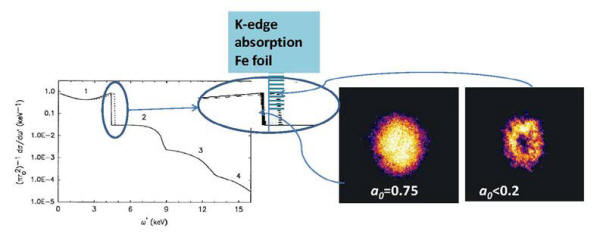- Home
- Capabilities
- Science Highlights
- Operations
- Publications
-
ES&H
- Experiment Start-up
- Laser Safety
Collider-Accelerator Dept.
- C-AD ES&H Resources
- Staff
- Users' Place
- Apply for Access
Demonstration of Mass-shift and High Harmonics in ICS X-ray Spectrum
The recent improvements in the ATF’s CO2 laser, in particular, using CO2 isotopes for the picosecond pulse amplifier, allowed us to attain a single pulse regime in excess of 1 TW peak power. This upgrade led to a revival in the interest in fundamental studies of the higher order nonlinear effects in Inverse Compton Scattering (ICS) that are related to the electrons’ quiver motion at relativistically high laser intensities. The experiment carried out by researchers and students from UCLA’s Physics Dept. provided the first demonstration of the laser induced mass shift effect in the ICS spectrum.
As illustrated below, the shift in the fundamental high energy edge of
the spectrum
 is due to the change in effective electron mass
is due to the change in effective electron mass
 caused by a relativistically strong laser beam characterized by the normalized laser strength
parameter
caused by a relativistically strong laser beam characterized by the normalized laser strength
parameter
a02 = 3.7 x 10-19I?2, for I in Watts/cm2 and ? in µm.
This shift was revealed by filtering out the high energy portion of the spectrum using a carefully
selected combination of the K-edge absorption filter and the e-beam’s energy. A central dip in
the angular ICS distribution visible at the relatively low laser intensity a0
<< 1 (see right color
pattern on figure below) disappears at the increased intensity, a0 ~ 1 (left pattern).

Demonstration of mass-shift effect in the ICS spectrum; left plot – simulated spectra; color profiles to the right are x-ray angle distributions experimentally observed with MCP.




